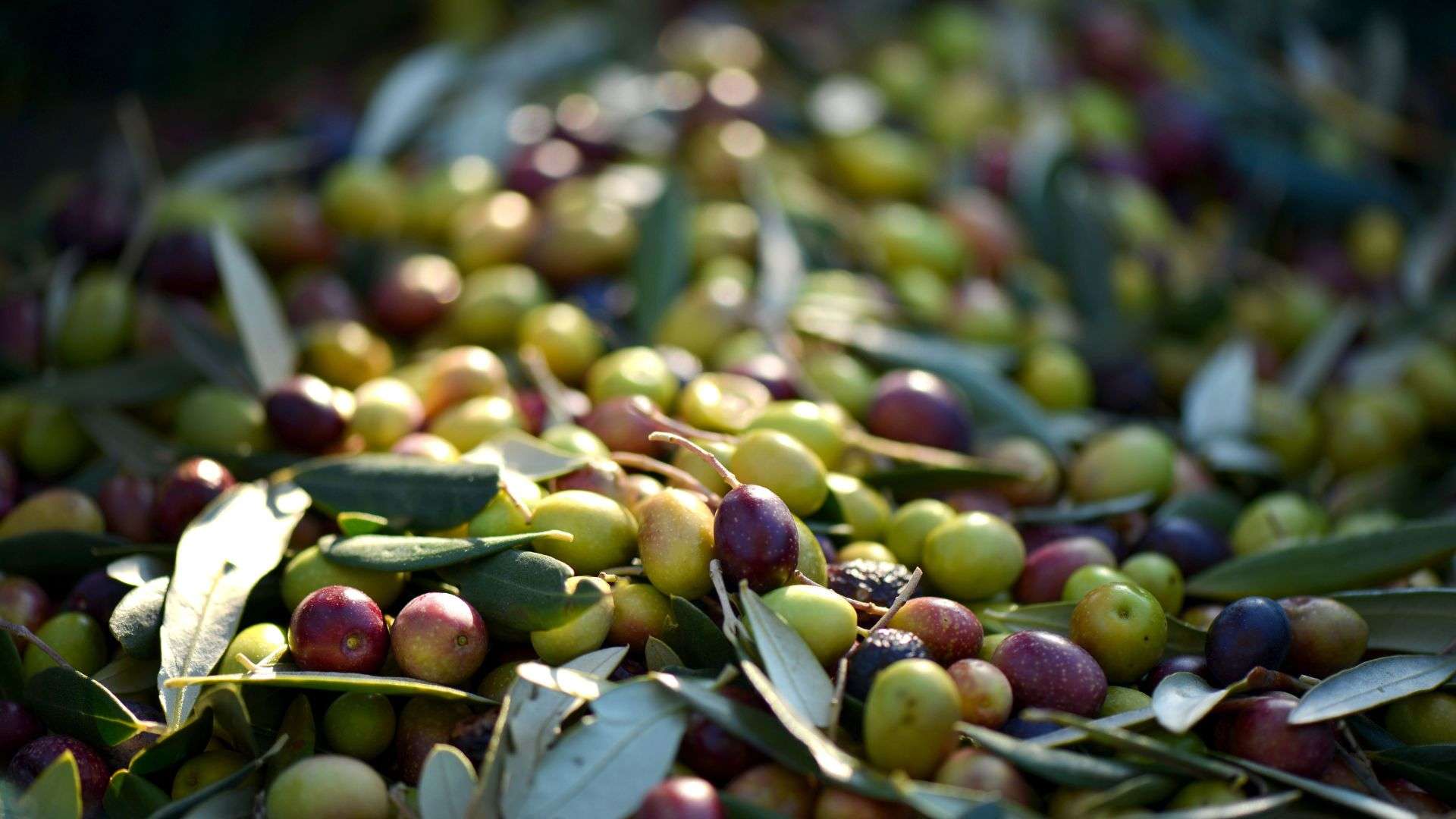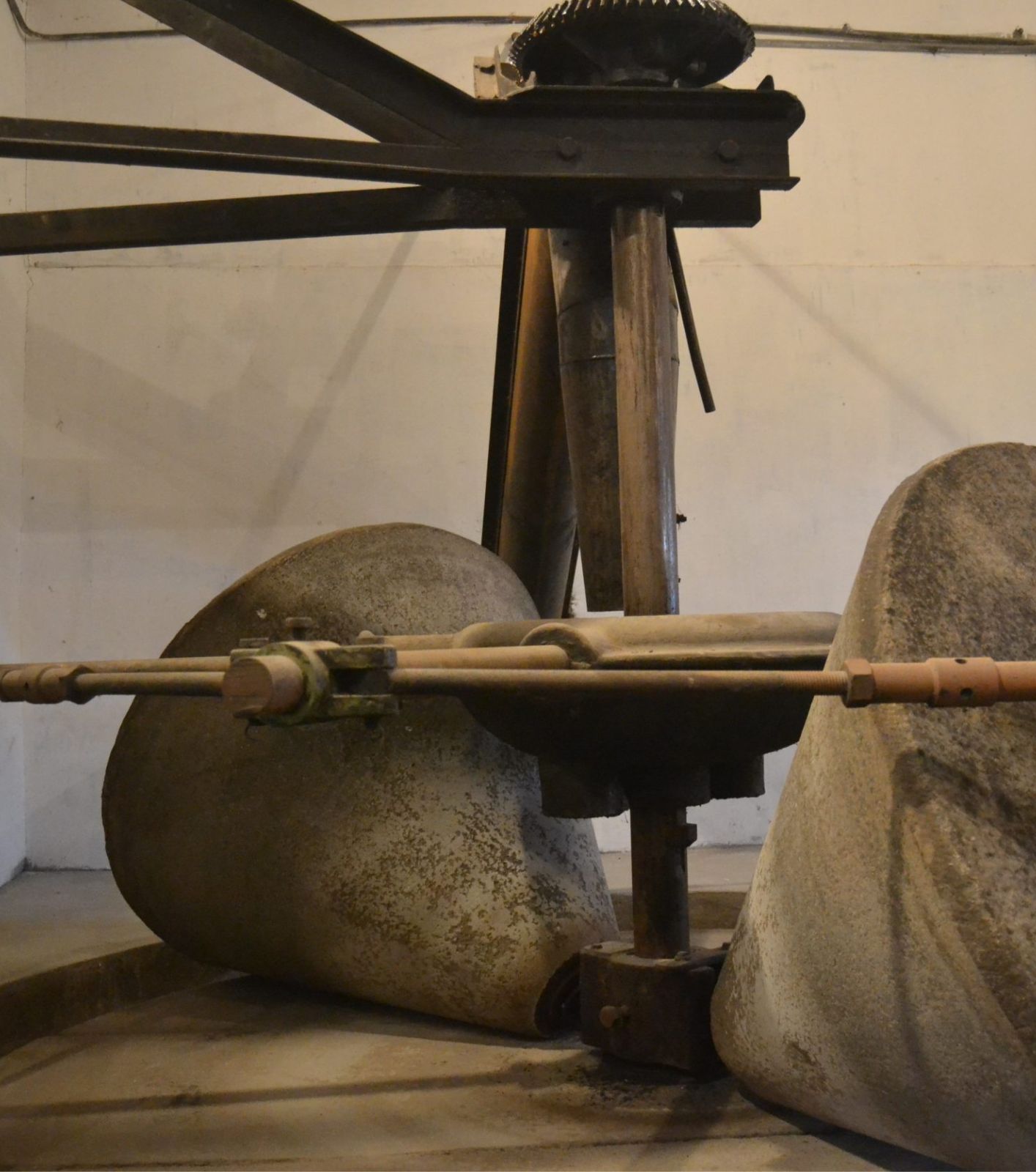Productive process
ACEITES CLEMEN
Preliminary phase
Harvesting
In our region, farmers collect olives in various ways, but the main method is by shaking the tree, called VAREO.
They use a long pole and hit the branches to make the olives fall onto a net placed below.
Another common method is HANDPICKING, where they use the well-known “macaco” that they carry on their chest. Usually, they climb a ladder placed on the olive tree.
Another method that is beginning to be used is VIBRATION. This system can only be applied to young olive trees, usually of the Carrasqueña variety. A mechanical arm installed on the trunk vibrates the tree so that the olives fall onto the canvas placed by the arm, to be later collected in a basket or trailer.
There are other systems, but these are the main ones. It is worth noting that to be able to harvest the olives using these methods, they must be in their mature state, as except for handpicking, the rest involves hitting or moving the fruit to help it fall. There is also a manual vibrator that performs the same functions as the mentioned one but on a branch.

Cleaning
This process is done in our oil mill. The farmers drop the olives into a hopper installed on the ground that will serve as a receiver for the cleaning system. This system consists of 3 steps. The first one is the removal of mud and leaves. The second step is the cleaning, with removal of wet mud, stones or other impurities, and the third step is transportation for drying and weighing.

Weighing
The weight of the olives is measured when they are clean. An electronic scale measures the weight in 100-kilogram pulses. A final conveyor belt will lift the olives up to the storage hopper.

Storage
The olives are stored for the shortest possible time so that the oil to be produced contains all the natural goodness of this fruit.
Preliminary phase
Once the olive has been stored and rested for at least 12 hours (at least if the milling system is with rollers – in our mill you can see this system in our museum), it goes through the MILLING process. In the past, milling was carried out with conical rollers that crushed the olives with the force exerted by the weight of the rollers. As the rollers were conical, heavier on the outer zone, the mass was accumulated on the outside, in grooves made in the stone. With a small shovel, this mass was collected and taken to the mixer (second phase).
In modern times, mills that use stone rollers (rulos) are very few. Why? It’s very simple: their maintenance, cleaning, and replacement are complex, and the milling process is slow. So, was this system not good? Yes, it is good, but not the most suitable for milling a large number of olives.
Mixing
The mass then goes to the mixer. Our mixer consists of 3 horizontal bodies, each weighing about 1500 kilos.
It is made up of two layers, the inner layer made of stainless steel and the outer layer made of sheet metal, with water at a controlled temperature in between. This water is in contact with the mass and helps it reach the appropriate temperature for this phase of the process. Why? The mixing helps the oil molecules to come together and separate from the mass. Mixing helps with this. About two hours is enough time to achieve an optimal point of oil molecule bonding. The old mixers, like the one in the photo, were either made of masonry or stainless steel and were vertical.
In this process, we do NOT add anything, neither hot water (to speed up the process and stretch the extra virgin olive oil), nor enzymes (that accelerate the process and weaken its natural state), nor talc (which assimilates water and reduces it in the mass), nor any other element outside of the process.
Extraction
After the mixing, we have to separate the liquids from the solids. Olive oil extraction has occurred in many ways throughout history, from ancient Roman presses to more modern mills (like the one in our museum). These systems have completely taken a back seat with the arrival of decanters. We can use two types of systems for this:
One is the traditional hydraulic press, in which the olive oil falls by its weight, making natural filter baskets, separating the solid part from the liquid (photo). A “pie” of baskets and mass is formed (see photo). In the past, the loads were formed manually using pots to transport the mass from the mixer to the basket and break the mass with the hands. Later, a manually operated automatic mass loader was used (see photo).
Once the “cake” is formed, it is transported via rails to the hydraulic press where the pressure exerted by water will cause the solid part (pomace) to remain between the mats and the liquid part (alpechín and oil) to fall and be collected in the decanters. A sieve (a very thin vibrating stainless steel plate) ensures that the solid parts accompanying the liquids do not pass into the decantation tanks or centrifuge (the next phase). Therefore, the oil and alpechín go to the decanters or centrifuge. The solid remains that are left in the mats are removed and stored in a hopper so that later the oil extraction equipment can extract the oil it may contain (between 3 and 5%), which will be called olive pomace oil.
Second: Hammer mill. Unlike the rollers, the hammer mill is small in size and easy to clean. Inside, it has “stones” that break the olives and make them into a paste that will be taken to the mixer by a mass pump. The mixer is horizontal (previously vertical) and has three compartments. This makes the paste rest more, allowing for better extraction of the oil. We then use another pump to take the paste from the mixer to the decanter. The decanter performs the same function as the hydraulic press, but unlike the press, the decanter is much cleaner, smaller, and can extract five times more oil in the same amount of time. This means we gain in cleanliness and speed of extraction. The decanter separates a liquid part from a solid part. Unlike the press, the solid part of this extraction is more humid and contains less oil. From the decanter, the liquid part goes to the centrifuge, passing previously through a sieve.
Centrifugation and Decantation.
This process after extraction helps to completely clean the extra virgin olive oil (which still contains water and oily sediments) and make it suitable for consumption. In the past, decantation was the only possible system for obtaining clean oil, and the process was as follows: a first tank was filled, and the oil (less dense) would rise to the top, sediment to the bottom, and in the middle, there would be the “alpechín” (water containing the olive). The stored decanters were connected by vessels at the top, and the oil passed slowly and at a temperature between 15 and 18°C, going from tank to tank until it reached the last decanter, where it arrived practically clean.
Today, a machine called a “Centrifuge” is used for this process, to which hot water is added at a temperature NOT exceeding 30°C. We add water at 16°C to perform the separation of the parts, on one hand, the oil, and on the other hand, the “water and oily sediments.”
The decanters began to take a back seat with the incorporation of a phase in the milk improvement process, centrifugation, in the olive oil extraction process. A German company incorporated this system into the oil process, improving the time to obtain the oil and the space needed to store the oil produced for at least two days (estimated time for the oil to be 80% clean) before being transferred to the cellar.
Today, it has been proven that the centrifugation of extra virgin olive oil preserves its properties and improves its quality in storage.

San Antonio, 9 03610. Puebla de Sancho Pérez CP 06310 (Badajoz)
+34 924 575 214
+34 620 914 092
Más info




